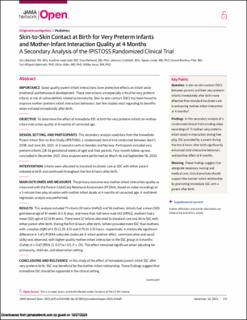| dc.contributor.author | Lilliesköld, Siri | |
| dc.contributor.author | Kolz, Karoline Lode | |
| dc.contributor.author | Rettedal, Siren | |
| dc.contributor.author | Lindstedt, Johanna | |
| dc.contributor.author | Linnér, Agnes | |
| dc.contributor.author | Lillevik, Hanne Markhus | |
| dc.contributor.author | Ahlqvist-Björkroth, Sari | |
| dc.contributor.author | Ådén, Ulrika | |
| dc.contributor.author | Jonas, Wibke | |
| dc.date.accessioned | 2024-02-23T11:42:06Z | |
| dc.date.available | 2024-02-23T11:42:06Z | |
| dc.date.created | 2023-12-20T11:06:47Z | |
| dc.date.issued | 2023 | |
| dc.identifier.citation | Lilliesköld, S., Lode-Kolz, K., Rettedal, S., Lindstedt, J., Linnér, A., Pike, H. M., ... & Jonas, W. (2023). Skin-to-Skin Contact at Birth for Very Preterm Infants and Mother-Infant Interaction Quality at 4 Months: A Secondary Analysis of the IPISTOSS Randomized Clinical Trial. JAMA Network Open, 6(11), e2344469. | en_US |
| dc.identifier.issn | 2574-3805 | |
| dc.identifier.uri | https://hdl.handle.net/11250/3119617 | |
| dc.description.abstract | Importance Good-quality parent-infant interactions have protective effects on infant socio-emotional and behavioral development. These interactions are especially critical for very preterm infants at risk of vulnerabilities related to immaturity. Skin-to-skin contact (SSC) has been found to improve mother–preterm infant interaction behaviors, but few studies exist regarding its benefits when initiated immediately after birth.
Objective To determine the effect of immediate SSC at birth for very preterm infants on mother-infant interaction quality at 4 months of corrected age.
Design, Setting, and Participants This secondary analysis used data from the Immediate Parent-Infant Skin-to-Skin Study (IPISTOSS), a randomized clinical trial conducted between April 1, 2018, and June 30, 2021, at 3 neonatal units in Sweden and Norway. Participants included very preterm infants (28-33 gestational weeks of age) and their parents. Four-month follow-up was concluded in December 2021. Data analyses were performed on March 16 and September 18, 2023.
Intervention Infants were allocated to standard incubator care or SSC with either parent initiated at birth and continued throughout the first 6 hours after birth.
Main Outcomes and Measures The primary outcome was mother-infant interaction quality as measured with the Parent–Child Early Relational Assessment (PCERA), based on video recordings of a 5-minute free-play situation with mother-infant dyads at 4 months of corrected age. A multilevel regression analysis was performed.
Results This analysis included 71 infants (31 twins [44%]) and 56 mothers. Infants had a mean (SD) gestational age of 31 weeks 3 (1.3) days, and more than half were male (42 [59%]); mothers had a mean (SD) age of 32 (4.9) years. There were 37 infants allocated to standard care and 34 to SSC with either parent after birth. During the first 6 hours after birth, fathers provided more SSC than mothers, with a median (IQR) of 3.25 (2.25-4.5) and 0.75 (0-2.5) hours, respectively. A statistically significant difference in 1 of 5 PCERA subscales (subscale 3: infant positive affect, communicative and social skills) was observed, with higher-quality mother-infant interaction in the SSC group at 4 months (Cohen d = 0.67 [95% CI, 0.17 to 1.17]; P = .01). This effect remained significant when adjusting for primiparity, child sex, and observation setting.
Conclusions and Relevance In this study of the effect of immediate parent-infant SSC after very preterm birth, SSC was beneficial for the mother-infant relationship. These findings suggest that immediate SSC should be supported in the clinical setting.
Trial Registration ClinicalTrials.gov Identifier: NCT03521310 | en_US |
| dc.language.iso | eng | en_US |
| dc.publisher | JAMA Network | en_US |
| dc.rights | Navngivelse 4.0 Internasjonal | * |
| dc.rights.uri | http://creativecommons.org/licenses/by/4.0/deed.no | * |
| dc.title | Skin-to-Skin Contact at Birth for Very Preterm Infants and Mother-Infant Interaction Quality at 4 Months: A Secondary Analysis of the IPISTOSS Randomized Clinical Trial | en_US |
| dc.type | Peer reviewed | en_US |
| dc.type | Journal article | en_US |
| dc.description.version | publishedVersion | en_US |
| dc.rights.holder | The authors | en_US |
| dc.subject.nsi | VDP::Medisinske Fag: 700 | en_US |
| dc.source.volume | 6 | en_US |
| dc.source.journal | JAMA Network Open | en_US |
| dc.source.issue | 11 | en_US |
| dc.identifier.doi | 10.1001/jamanetworkopen.2023.44469 | |
| dc.identifier.cristin | 2216177 | |
| cristin.ispublished | true | |
| cristin.fulltext | original | |
| cristin.qualitycode | 1 | |

